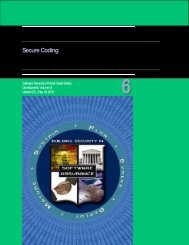Architecture and Design Considerations - Build Security In - US-CERT
Architecture and Design Considerations - Build Security In - US-CERT
Architecture and Design Considerations - Build Security In - US-CERT
You also want an ePaper? Increase the reach of your titles
YUMPU automatically turns print PDFs into web optimized ePapers that Google loves.
value for the variable’s type. Identify all variables <strong>and</strong> data stores that receive information from external sources, <strong>and</strong><br />
apply input validation to make sure that they are only initialized to expected values. CWE-665<br />
» Restrict executables: Run the code in a “jail” or similar s<strong>and</strong>box environment that enforces strict boundaries between<br />
the process <strong>and</strong> the operating system, which may effectively restrict which code can be executed. Examples include<br />
the Unix chroot jail <strong>and</strong> AppArmor. CWE-94<br />
<strong>Design</strong> Phase:<br />
» Preserve OS comm<strong>and</strong> structure to mitigate risk OS comm<strong>and</strong> injection. CWE-78<br />
» Use modular cryptography: <strong>Design</strong> the software so that one cryptographic algorithm can be replaced with another,<br />
<strong>and</strong> do not develop custom cryptographic algorithms. Specify the use of languages, libraries, or frameworks that make<br />
it easier to use strong cryptography. (Consider the ESAPI Encryption feature.) CWE-327<br />
» Encrypt data, with a reliable encryption scheme, before transmitting sensitive information. CWE-319<br />
» Specify the download of code only after integrity check. CWE-494<br />
» Protect against Denial of Service attacks: Mitigate race conditions <strong>and</strong> minimize the amount of synchronization<br />
necessary to help reduce the likelihood of a denial of service where an attacker may be able to repeatedly trigger a<br />
critical section by using synchronization primitives (in languages that support it). Only wrap these around critical code<br />
to minimize the impact on performance. Use thread-safe capabilities such as the data access abstraction in Spring.<br />
CWE-362<br />
» Protect against CSRF: Mitigate risk from Cross-Site Request Forgery (CSRF) by using the ESAPI Session<br />
Management control <strong>and</strong> anti-CSRF packages such as the OWASP CSRFGuard. Identify especially dangerous<br />
operations. When the user performs a dangerous operation, send a separate confirmation request to ensure that the<br />
user intended to perform that operation. CWE-352<br />
» Authenticate: If some degree of trust is required between the two entities, then use integrity checking <strong>and</strong> strong<br />
authentication to ensure that the inputs are coming from a trusted source. <strong>Design</strong> the product so that this trust is<br />
managed in a centralized fashion, especially if there are complex or numerous communication channels. CWE-602<br />
» Preserve web page structure to mitigate risk from cross-site scripting. CWE-79<br />
Resource<br />
» “Key Practices for Mitigating the Most Egregious Exploitable Weaknesses.” SwA Pocket Guide Series.<br />
DHS <strong>Build</strong> <strong>Security</strong> <strong>In</strong> (BSI) portal, 24 May 2009. .<br />
<strong>Architecture</strong> <strong>and</strong> <strong>Design</strong> <strong>Considerations</strong> for Secure Software 32
















